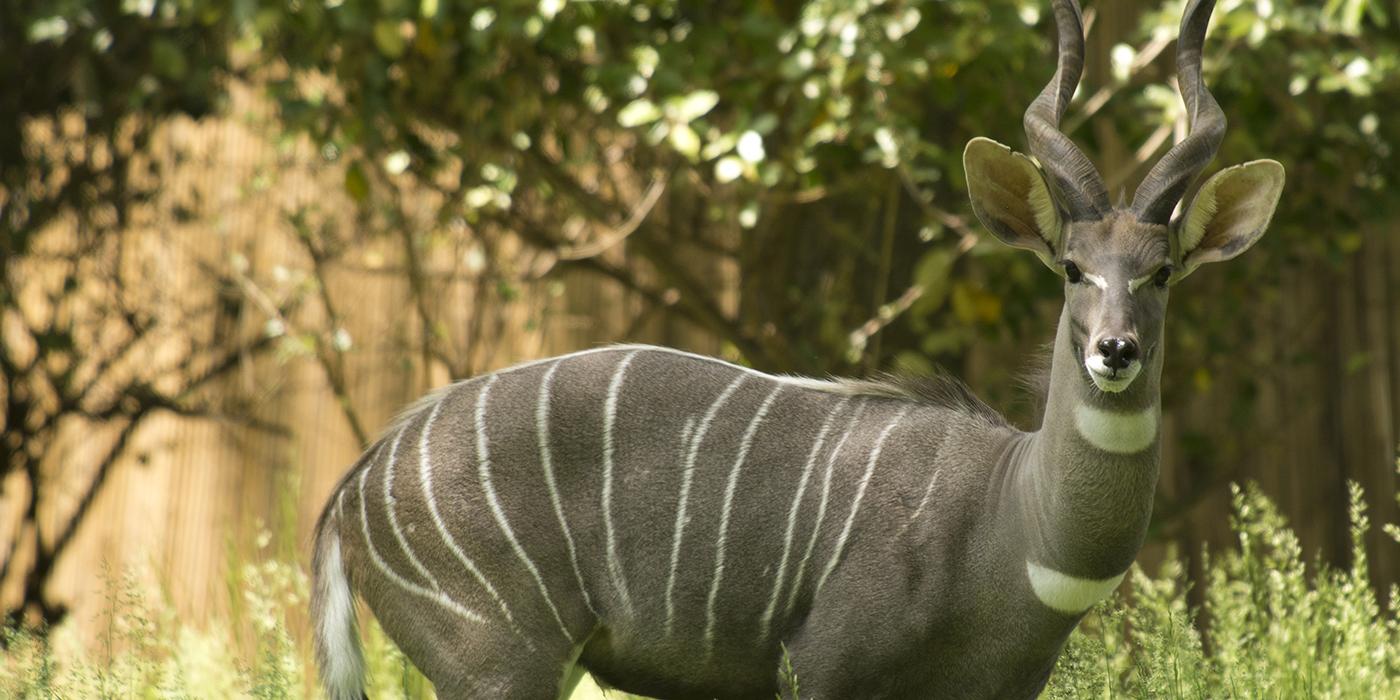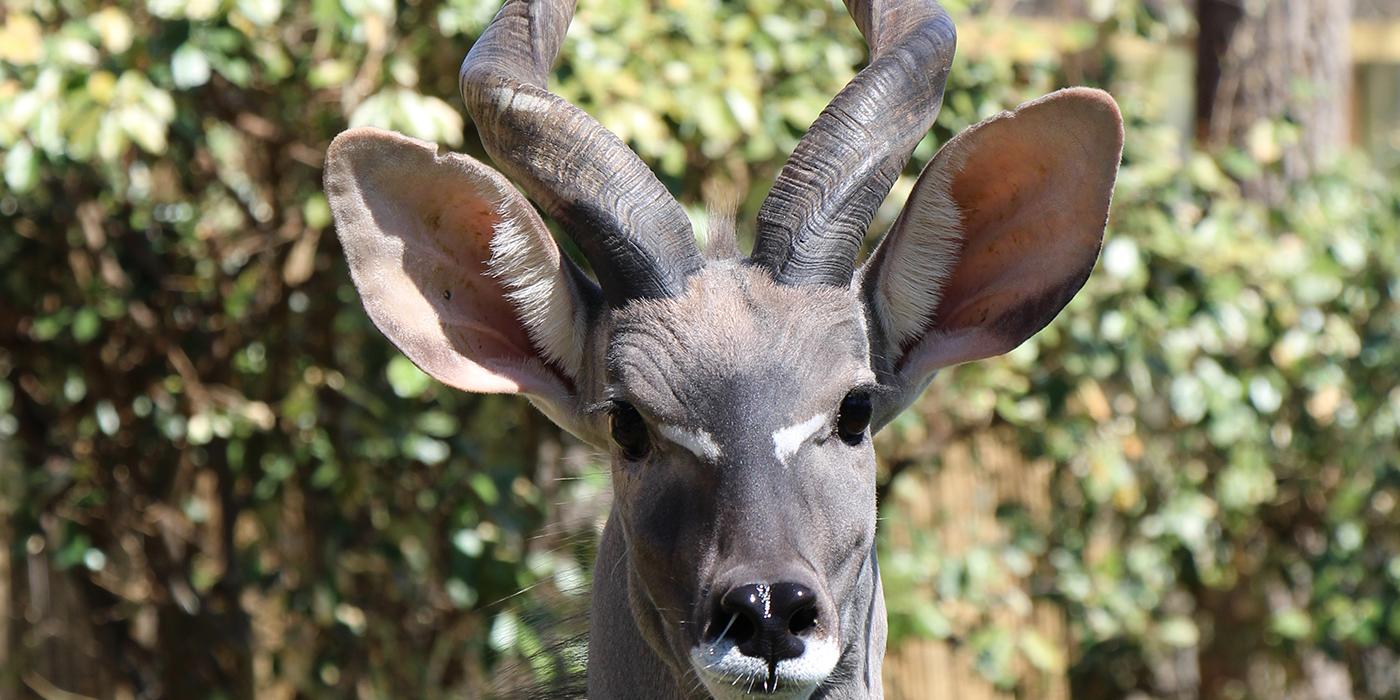Physical Description
Lesser kudu are one of the more striking species of antelope. This species has a white stripe running down its back with 11 to 14 stripes coming off it and down the animal's side. Stripes stand out on a grayish-brown coat on males and a reddish-brown coat for females. Males are also adorned with impressive spiraled horns which will twist 2.5 times and can grow up to 3.5 feet (60 to105 centimeters) long. Facial markings consist of black stripes running from each eye towards the nose, and a white stripe running from each eye to the center of the face. Legs are fawn colored, with white spots above the hooves. Two white spots adorn either side of the neck.
Large ears allow for enhanced listening abilities and predator detection, and the coloration of lesser kudu is such that when individuals remain motionless they are very difficult to detect in their natural habitat.
Size
Lesser kudu weigh 130 to 230 pounds (60 to 105 kilograms) and stand 35 to 43 inches (90 to 110 centimeters) at the shoulder.
Native Habitat
Lesser kudu reside in the arid and semi-arid areas of northeastern Africa, including parts of Ethiopia, Somalia, Kenya, Sudan, Uganda and Tanzania. Scrublands and woodlands make up the majority of this territory, with lesser kudu primarily avoiding open spaces and long grasses. This species has been documented at 5,700 feet (1740 meters) near Mount Kilimanjaro.
Lifespan
Lifespan for lesser kudu is 10 to 15 years in the wild, and up to 20 years in human care.
Communication
Lesser kudu emit a bark vocalization when startled which warns others of potential predators.
Food/Eating Habits
Feeding primarily at dusk and dawn, lesser kudu eat a wide array of leaves, shrubs, twigs, grasses, herbs and roots. An inhabitant of a traditionally dry area, lesser kudu have adapted to be independent of primary water sources, instead hydrating from the moisture collected in leaves.
Orchard grass hay, alfalfa hay and herbivore pellets make up the diet of lesser kudu at the Smithsonian's National Zoo. This species will also receive woody browse and biscuits with enrichment.
Sleep Habits
Largely nocturnal animals, lesser kudu will seek shelter and security in dense thickets by sunrise. They forage around sunset and sunrise.
Social Structure
Females form groups of two or three, but males generally remain solitary, occasionally forming small bachelor groups. Territorial behavior is nonexistent; no real hierarchical groups have been documented, and fighting only occurs rarely, usually around mating time.
Reproduction and Development
Lesser kudu become sexually mature around 15 to 18 months, but males will not have achieved the social status needed to mate until age four or five. Shoving matches ensue between males where heads and horns will be pressed together in an attempt to force horns upon the opponent's nape. Contests continue between males and females, where both lesser kudu will stand on hind legs and attempt to push each other over, with the male normally winning. Despite emerging the victor, the male will never show aggression toward the female during the process.
Gestation lasts six to eight months, and the doe gives birth to a single calf after separating herself from the group. The calf will lay concealed by surrounding brush while its mother forages for food. Offspring weigh 9 to 16.5 pounds (4 to 7.5 kilograms) and have a 50 percent mortality rate by six months of age; around the same time, calves are weaned from their mothers.
Conservation Efforts
The greatest threat to lesser kudu is the outbreak of rinderpest transmitted by contact with cattle that occurred in the eastern regions of Kenya in the mid-1990s. Rinderpest was a relative of the measles virus, and had the potential to kill up to 95 percent of herds that encountered it. However, scientists deemed it had been completely eradicated in 2011, and populations of lesser kudu are expected to recover.
Hunting is also a factor in the conservation of lesser kudu, but the shyness of the species often keeps it protected in the forest and safe from human hunting. Still, it is pursued for its meat and horns, which can be hollowed out and used as wind instruments or in spiritual rituals. As with many animals, an increase in human development also affects lesser kudu due to habitat being lost to farmland and human encroachment. About one third of the estimated lesser kudu population can be found in protected areas, but the improved management and protection of these areas would offer a more optimal survival prospect for this species. Overgrazing also presents an issue for lesser kudu.
Currently, with the eradication of the rinderpest virus, the future for lesser kudu looks more promising. Lesser kudu live in several national parks.
Help this Species
Reduce, reuse and recycle — in that order! Cut back on single-use goods, and find creative ways to reuse products at the end of their life cycle. Choose recycling over trash when possible.
Are you a student? Did you love what you learned about this animal? Make it the topic of your next school project, or start a conservation club at your school. You'll learn even more and share the importance of saving species with classmates and teachers, too.
Meet the Animals
Five lesser kudus live at Cheetah Conservation Station: adult female Rogue, her son Machi (born March 2021), her daughter Jamilah (born March 2022), adult female "Gal" (short for Galactus), and her son Zahi (born February 2022). Jamilah was the first female lesser kudu calf born at the zoo.
Zoo visitors can see Rogue, Gal, Zahi and Jamilah in the morning and Machi in the afternoon. The kudus share a habitat with the Abyssinian ground hornbills.
Smithsonian's National Zoo and Conservation Biology Institute. (n.d.). Lesser kudu. Retrieved December 1, 2025, from https://nationalzoo.si.edu/animals/lesser-kudu
Animal News

Giant Panda Qing Bao Gets a Checkup ›

7 Spooktacular Animal Facts for Halloween ›


